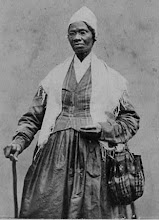Sunday, May 10, 2009
Making a Difference Introduction
Essay
Throughout the course of history, there have been a great number of individuals who have made a difference. Many of these people are very well known and famous, while others remain below the public radar. One person who I believe does not receive enough credit is Sojourner Truth, a black woman who lived during the nineteenth century. I think that Sojourner Truth made a difference in the world through the obstacles that she had to overcome in her life and her work as an abolitionist and a women’s rights activist.
Sojourner Truth was born under the name Isabella Baumfree sometime during the year 1797, the exact date remains unknown (
On June 1, 1843, Truth changed her name to Sojourner Truth, Sojourner meaning “one who stays briefly” (Connor 4). She then decided to leave to preach about abolition, telling her friends, “The Spirit calls me, and I must go” (Connor 4). The next year, in 1844, she joined the Northampton Association of Education and Industry, located in
Sojourner Truth is an individual who made a difference in the world for many reasons. One is due to the obstacles she had to overcome to get to where she was at the end of her life. She was a slave and a woman. Even when she was freed, she was still looked down upon by many people at the time because women were considered inferior and unequal to men. She also could not read or write, but that did not stop her from becoming a fantastic public speaker. Truth was not intimidated by anyone, and even though it seemed like her circumstances would make it impossible to succeed in life, she overcame them. Truth also made a difference because of her relentless drive to fight for what she believed in. Women’s rights and abolitionism were controversial subjects in Truth’s day, but she spoke out against the status quo because she knew that it was wrong for her to just sit back and let it happen. She knew that she had to do something. Every time she stood up to speak, she knew that there was a threat of someone trying to harm her, but she did it anyway because she knew it was right. Even in her old age she continued to fight for women’s rights and abolitionism. Weeks before her death she was asked by a reporter kept her going. She responded with, “I think of the great things” (Roop 69). Sojourner Truth made a difference in the world because she fought for what was right even though it was difficult and dangerous.
There are many people in the world who have made a difference in one way or another. Many of them are celebrated heroes; many of them go completely unnoticed by the public. One person who I believe goes relatively unnoticed is Sojourner Truth, a black women’s rights activist and abolitionist during the nineteenth century. I hope more people learn about Sojourner Truth and recognize that she truly is a person who made a difference.
Works Cited
Works Cited
Connor, Kimberly Rae. "Sojourner Truth: Slave, Prophet, Legend." African American Review 30.n2 (Summer 1996): 294(4). Academic OneFile. Gale. Westborough Public Library. 10 May 2009
Krass, Peter. Sojourner Truth: Antislavery Activist.
Roop, Connie. Sojourner Truth.
Samra, Matthew K. "Shadow and substance: the two narratives of Sojourner Truth." The
Yee, Shirley J. "Sojourner Truth: A Life, a Symbol." Journal of Women's History 10.n1 (Spring 1998): 174(9). Academic OneFile. Gale. Westborough Public Library. 10 May 2009
10 May 2009.
10 May 2009.
10 May 2009.
10 May 2009.
10 May 2009.




